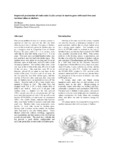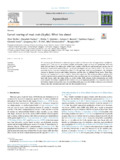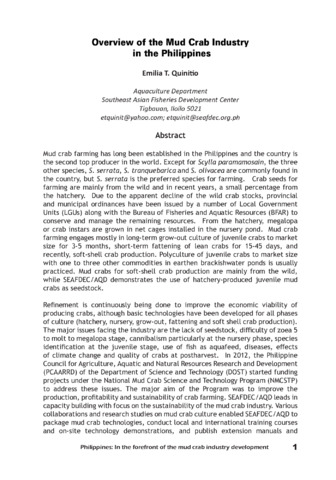Improved production of mud crabs Scylla serrata in marine pens with used tires and bamboo tubes as shelters
- Global styles
- MLA
- Vancouver
- Elsevier - Harvard
- APA
- Help

閲覧/開く
日付
2007Page views
4,530ASFA keyword
AGROVOC keyword
Taxonomic term
Metadata
アイテムの詳細レコードを表示する
Share
抄録
One serious problem in mud crab farming systems is cannibalism and low survival, but this can been offset by provision of shelters. Two types of shelters were tested on mud crabs grown in bamboo pens set in a mangrove area in Tiniguiban Cove in Puerto Princesa. Six pens, each 3 m x 3 m in area, were built side by side (the whole array 9 m x 6 m in area). Two pens were provided bamboo tubes, two had used tires, and two had both shelter types. The bamboo tubes were about 46 cm long and 13 cm in diameter, open on both ends, and each with a node retained as partition. The bamboo tubes were laid in one layer at the middle of the pens, 48 tubes in each of the two pens. The used tires were 50 cm in diameter, placed 20 cm apart in one layer in the middle of the pens, 12 tires in each of two pens. In the two pens that had both shelter types, half the number of bamboo tubes and used tires were laid out. All shelters were tied and did not move off the bottom. Juvenile crabs of 46 g body weight were stocked at 63/pen or 7/m2. The crabs were fed chopped trash fish at 5% of body weight daily at 0800 h and 1600 h. Mud crabs in the pens with bamboo tubes as shelters had the best survival (79%), weight gain (81 g), net production (4.5 kg/pen), and feed conversion ratio (4.9), as well as net income (P544,202/ha-yr) and return on investment (48%). The results clearly indicated that bamboo tubes were better shelter for juvenile mud crabs than used tires. Bamboo tubes were presumably more familiar to mud crabs reared in bamboo pens. Having node partitions in the middle, the bamboo tubes had smaller and safer hiding places. These shelters effectively reduced crowding, aggression, and cannibalism, and thus increased the survival and growth of mud crabs. The used tires evidently did not provide a good shelter configuration nor sufficient protection for mud crabs in bamboo pens.
Suggested Citation
Basaya, M. C. (2007). Improved production of mud crabs Scylla serrata in marine pens with used tires and bamboo tubes as shelters. In T. U. Bagarinao (Ed.), Research Output of the Fisheries Sector Program (Vol. 2. Reports on Fisheries and Aquaculture, pp. 150-151). Quezon City, Philippines: Bureau of Agricultural Research, Department of Agriculture.
Type
Book chapterISBN
9718511776
Related items
Showing items related by title, author, creator and subject.
-
Larval rearing of mud crab (Scylla): What lies ahead
Waiho, Khor; Fazhan, Hanafiah; Quinitio, Emilia T. ; Baylon, Juliana C.; Fujaya, Yushinta; Azmie, Ghazali; Wu, Qingyang; Shi, Xi; Ikhwanuddin, Mhd; Ma, Hongyu (Elsevier, 2018)
The increasing global demand for mud crabs (genus Scylla) and threats to the wild populations highlight the urgency of fully rearing them in captivity. Despite considerable progress in mud crab production, most crab farms ...
; Baylon, Juliana C.; Fujaya, Yushinta; Azmie, Ghazali; Wu, Qingyang; Shi, Xi; Ikhwanuddin, Mhd; Ma, Hongyu (Elsevier, 2018)
The increasing global demand for mud crabs (genus Scylla) and threats to the wild populations highlight the urgency of fully rearing them in captivity. Despite considerable progress in mud crab production, most crab farms ... -
Mud crab pond and pen culture
Rodriguez, Eduard M. (University of the Philippines Aquaculture Society, Inc, 2001) -
Overview of the mud crab industry in the Philippines
Mud crab farming has long been established in the Philippines and the country is the second top producer in the world. Except for Scylla paramamosain, the three other species, S. serrata, S. tranquebarica and S. olivacea ...




